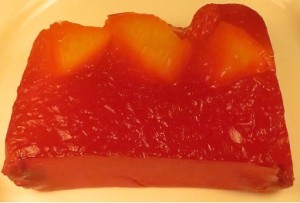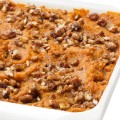 Agar-agar is a vegan substitute for gelatin. Traditional gelatin is made with powdered cow hooves. Agar-agar is made from dried red algae. As with traditional gelatin, this vegan substitute has a neutral flavor and does NOT taste like seaweed.
Agar-agar is a vegan substitute for gelatin. Traditional gelatin is made with powdered cow hooves. Agar-agar is made from dried red algae. As with traditional gelatin, this vegan substitute has a neutral flavor and does NOT taste like seaweed.
According to the Science et Technologie au Service de la Creation Culinaire, a Japanese innkeeper in Kyoto named Tarozaemon Minoya discovered the gelling aspects of this seaweed during the 17th century. Having used red algae in a sauce for the evening meal, the innkeeper later found that after the inn had closed, the sauce had gelled.
Pictured below is a fruit gelatin I made using organic tropical fruit. For this product, I used 5 tsp. of agar-agar with 2 pints of water and 2 small packets of Crystal Light fruit punch. I emptied a can of organic tropical fruit into a square baking pan and added the liquid to the total 2 pints of water. After soaking the dried algae for 15 minutes, I brought the mixture to a boil and stirred it until the agar-agar was dissolved. I then poured it over the fruit and put it in the refrigerator to set.

You can also use agar-agar to make an aspic. Aspic is essentially a meat flavored gelatin that was discovered by French cooks. During the Medieval period, French cooks learned that when thick meat stocks cooled, they became a jelly like substance. The culinary technique for making this product was refined during the Renaissance when clarified broth was used to make clear gelatins that were then poured into decorative molds. This clarified meat gelatin became known as aspic. Meat aspics were made long before the creation of fruit gelatins.
The first fruit gelatin wasn’t made until 1897 and was produced by a cough medicine manufacturer named Pearl B. Wait. At his wife’s urging, he named this product, “Jell-O.” This product was not very successful and Mr. Wait eventually sold Jell-O to Orator Francis Woodward, the owner of the Genesee Food Company, for $450. In 1902, the Genesee Company launched a marketing campaign that featured ads in the Ladies Home Journal. Public interest was piqued and by year‘s end, $425,000 had been generated in sales.
Pictured below is a vegan aspic that was made using pan fried onions and mushrooms in a vegan beef broth to which I added a can of well drained spinach. I served slices of this aspic as a salad with vegan Catalina dressing and grape tomatoes.

Agar-agar can also be used to make such products as “whipped cream” salads. You’ve probably seen these products in the deli section of supermarkets. If you mix equal parts of fruit gelatin with vegan whipped cream, you get a jello salad. The salad pictured below is one of my very favorites … an Ambrosia whipped gelatin. I made it using coconut gelatin that I mixed with equal parts of vegan whipped cream in a food processor. I then stirred in drained mandarin oranges, coarsely ground pecans, and additional shredded dried coconut.

If you’re someone who misses cream pies and yogurt, you can use agar-agar to create vegan alternatives to these products. Instead of using water mixed with agar-agar and a packet of Crystal Light mix, try switching out the water with soy milk. The result won’t look like a cream filling. It will look like milk colored gelatin – but if you put the gelatin in a food processor, it will look liked a whipped cream filling. This filling can then be poured into a prepared pie shell and topped with vegan whipped cream. In the picture below, I topped my strawberry cream filling with a white chocolate cream and fresh strawberries!
When mixed with a touch of nutritional yeast, the whipped cream filling described in the preceding paragraph tastes like yogurt. As with the cream filling, run the yogurt gelatin through a food processor before serving it. The yogurt pictured below was made with a gelatin that I pureed with fresh blueberries and silk tofu (for added protein.) Additional blueberries were placed on the yogurt for added color and flavor when I served it.

I have even used agar-agar as a substitute for corn syrup in making fudge. Pictured below is a piece of peanut butter fudge. The fudge was made with unsweetened baker’s chocolate, fructose, margarine, vanilla, soy milk, and agar-agar. After making the chocolate, I poured it over a pan lined with coarsely chopped almonds and shredded coconut. The chocolate was refrigerated and after it was set, I cut it into squares. I then made a bite sized peanut butter “sandwich” using two pieces of almond-coconut fudge. The peanut butter fudge was topped with half of a pecan.

Pictured below is a chocolate flan I made using a chocolate gelatin that I made using soy milk, cocoa powder, fructose, vanilla, and agar-agar. Although I could have pureed this gelatin to make a chocolate cream, I served it with toasted peanuts, vegan caramel sauce, and whipped cream. It tasted just like a chocolate flan.

There are many uses for agar-agar. What you make with it is really only limited by your sense of imagination.
You can purchase Agar-Agar online through shops like Amazon.com.
Recipes for fruit gelatin and aspic may be found in my e-book, The Unintentional Vegan: Salads, Dressings, Dips, and Appetizers.
The recipe for the cream pie as well as cream cheese pie, chocolate flan with caramel sauce, and fudge will appear in my next book, The Unintentional Vegan: Sweets and Desserts which will be published through Amazon in December of 2013.
Regards,
David Chin, Author of:
Unintentional Vegan: Volume 1: Beef
Unintentional Vegan: Volume 2: Salads, Dressings, Dips, and Appetizers
Note: Both books are available as e-books through Amazon.com.
I also have a daily journal that may be found at:






1 Comment
Chia (324 comments)
July 19, 2013 at 10:31 amI’ve heard of agar agar but have not tried it. Am too timid to try baking or un-conventional ingredients as such. Probably have eaten it in purchased vegan baked goods. Thanks for sharing your expertise on this.